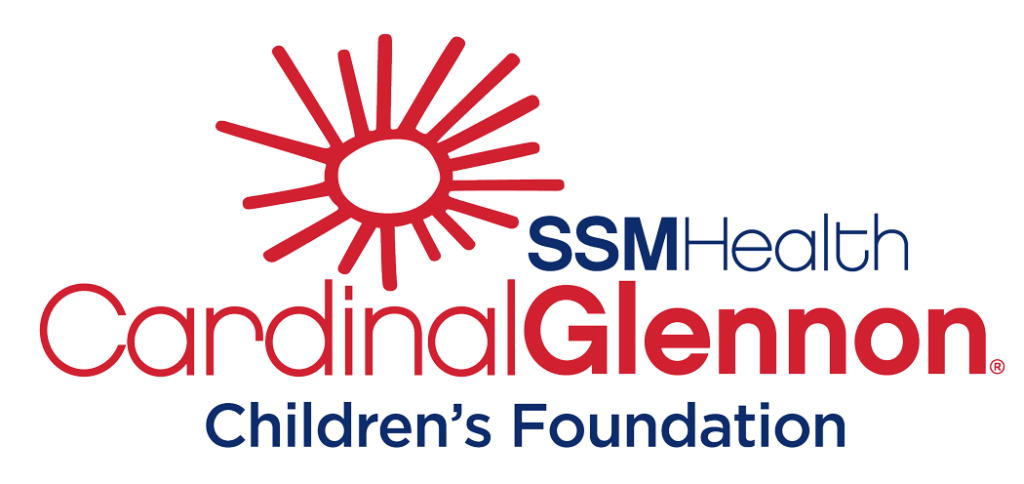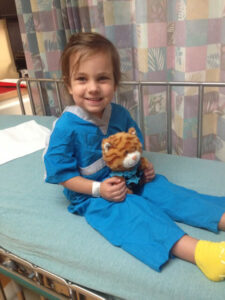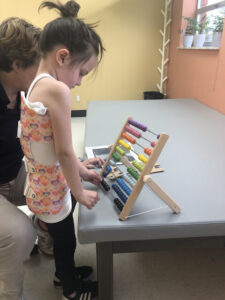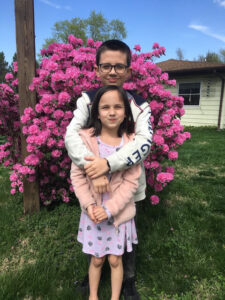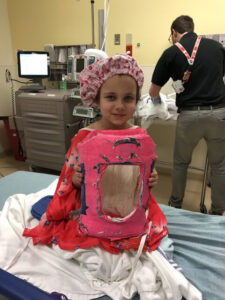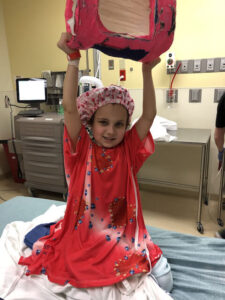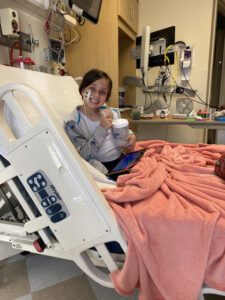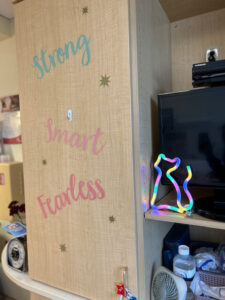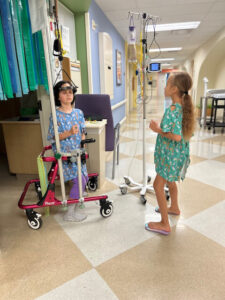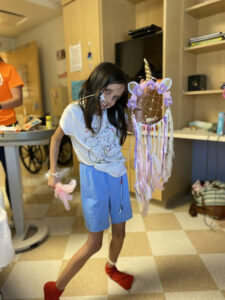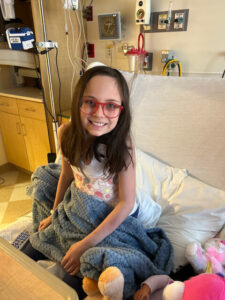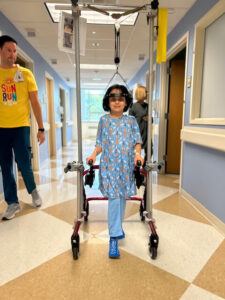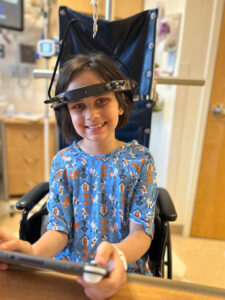Our Patients:
Anberlin Gripp
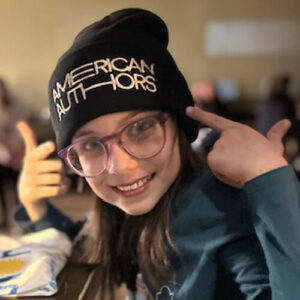
In between clinic visits, 12-year-old Anberlin from Belleville, IL sat in SSM Health Cardinal Glennon’s ground floor atrium with her Starbucks beverage talking about her favorite things. She talked about her love of legos, cats, Harry Potter and reading. “One of my cats is named Hemmingway,” Anberlin said. “I love reading and I love writing. And when I am a children’s author one day, I am going to donate my books to Cardinal Glennon.”
SSM Health Cardinal Glennon has been a second home to her since she was a toddler. “She had 3 sets of ear tubes and her adenoids removed twice before she was 4,” recalled Mom, Jenna. “I didn’t think we would need Cardinal Glennon until she was much older, but Anberlin had other plans,” laughed Jenna. “Cardinal Glennon has the neurofibromatosis clinic that I knew she needed. I have NF and her brother has it, too. I know Cardinal Glennon has the multidisciplinary care team in place since the 1980’s to work through her long-term treatment.”
Neurofibromatosis (NF) is a genetic disorder that causes non-cancerous growths to develop on any nerve ending throughout the body. This hereditary condition usually presents itself sometime during childhood. Complications of NF can include vision or hearing impairments, bone defects such as scoliosis, learning disabilities, seizures and benign skin tumors or other tumors.
“After Anberlin had her adenoids removed for the second time, Dr. Childers – her otolaryngologist, asked if she had ever been allergy tested,” Jenna said. “We had just started our visits to NF clinic, so we began seeing an allergist, as well. As part of NF clinic, she sees multiple subspecialists including orthopedics, ophthalmology, genetics, audiology, otolaryngology, neurology and behavioral health. “Anberlin was around 4 years old at that time, and two of the things discovered from initial visits were that she was allergic to whey protein and that she had scoliosis,” Jenna said.
“Once we eliminated whey protein from her diet, her eczema stopped, her congestion improved, her tummy bloat disappeared and she was much better,” Jenna said. “As far as her scoliosis, Dr. Place discussed the need for an eventual surgery when she was older. Until then, he recommended a bridge treatment prior to that which involved torso casting,” said Jenna.
Anberlin had three separate full torso casts over the course of a year. When those had proven minimally effective, Jenna advocated for Anberlin to have braces in lieu of casts allowing her more freedom for bathing, showering and independence. Anberlin had her first brace around age 7. It was about this same time that she grew out of her protein allergy. She continued her regular appointments and specialist follow-ups through the NF clinic until age 9 when it occurred to Jenna that Anberlin wasn’t eating very much. “It was post-Covid, she wasn’t eating much at all, and I felt like she hadn’t been gaining weight at all,” Jenna said. “I hadn’t thought a LOT about it because I was pretty certain her torso casts and braces had caused some eating aversions, but the pediatrician did recommend we make an appointment with her developmental pediatrician, Dr. Noonan, which we did in September 2021.”
Dr. Noonan saw Anberlin and recommended admission to the hospital for further evaluation and treatment. Several tests were done, but while awaiting results, she was placed on an ARFID feeding track. ARFID is Avoidant Restrictive Food Intake Disorder. Children with ARFID are extremely selective eaters and sometimes have little interest in eating food, which can lead to poor growth and poor nutrition. ARFID and anorexia are both eating disorders that make people restrict the food they eat. But, unlike anorexia, people with ARFID don’t eat less because they’re worried about their body image, shape, or size. People with ARFID aren’t trying to lose weight. Avoidances or restrictive habits are based on sensory characteristics or a fear of aversive consequences of eating (such as pain, vomiting, choking or an allergic reaction).
“Between the reactions from her early protein allergy and so much time in restrictive casts, food was something that often-brought Anberlin discomfort,” Jenna said. “We don’t really know if this is part of how we got here with her eating but it’s possible that it played some role.”
Anberlin spent 27 days admitted in the hospital. Throughout that time, she had 6 nasogastric tubes placed leading to an eventual gastrostomy button placement for an overnight supplemental feeding program. While testing did not reveal or identify a definitive cause for Anberlin’s failure to gain weight, it was clear she was simply burning too many calories to gain weight. She was discharged home on an overnight tube feeding regimen and plans for regular follow-up with her dietician, Dr. Noonan and other specialists.
From fall of 2021 through spring of 2023, Anberlin had regular appointments and clinic visits. Dr. Place felt that Anberlin was ready for corrective spinal surgery; however, her BMI was still not optimal for the losses that she might encounter during the surgical recovery. Dr. Noonan admitted Anberlin in March 2023 to take a deeper look into underlying causes of her poor weight gain in the hopes of finding answers AND hopefully having her gain weight for surgery later on in summer. Scans and metabolic tests did not reveal any obvious underlying causes; however, they DID discover a plexiform neurofibroma encasing her celiac artery. Plexiform neurofibromas are slow growing, painless, and locally infiltrating tumors. They grow along nerves and approximately 30-50% of individuals with NF1 have them. Until recently, surgery has been the main treatment option; however, they are often difficult to remove surgically because they are made of extensive nerve and blood vessel tissue that is mixed with normal tissue. In Anberlin’s case, because of its location, it is considered inoperable. Specialists with neurology, neurosurgery and oncology were all consulted for opinion. Dr. Christopher Hugge in The Costas Center at SSM Health Cardinal Glennon offered to meet with Jenna and Anberlin to discuss that as an option when they were ready.
The combination of Anberlin’s plexiform neurofibroma, her small stomach and the ARFIT were all reasons to support that her stomach simply could not hold a lot of volume. Anberlin was discharged home on a new formula for overnight feedings with a goal of gaining a bit more weight by her spinal surgery planned in the summer.
Anberlin was admitted for halo traction placement as a bridge treatment to spinal surgery on June 30, 2023. She would remain in halo traction for two weeks and have her spinal fusion on July 14. The weight of the traction would intentionally pull up and elongate her spine, enabling more flexibility for fusion.
“Cardinal Glennon really showed up for Anberlin during those two weeks,” Jenna said. “She was so nervous thinking about her traction and how scary it would be to move,” said Jenna. “Graham, her physical therapist, constructed a walker with modifications so that she could actually walk with her traction instead of being confined to bed,” Jenna said. “He walked with her every day and kept her stretching, walking and active. Just as important as that, his funny, goofy sense of humor kept her spirits up and always had a way of talking her through anything that made her upset,” said Jenna. “Jen – her Child Life Specialist was just as amazing. From 1:1 chats and activities to coordinated fun things like flower arranging, she went out of her way to ease Anberlin’s stress and help her feel more comfortable. Jen coordinated a whole customized room environment for Anberlin with Dec My Room, whose volunteers create personalized rooms for long term patients. This meant so much to Anberlin and really created a space she felt normal and relaxed in. Her room was so cool that she hosted a pre-surgical party,” exclaimed Jenna. “Jen and Anberlin planned the whole thing. The day before her surgery, they hosted an all-day event complete with party favors, snacks and music,” said Jenna. “She literally had all of her hospital friends stop by from doctors and nurses to the front desk greeters, security staff – EVERYONE,” Jenna said. “This and so many other experiences she’s had in the hospital with Child Life have left such an impact on her,” Jenna said. “She definitely wants to be a Child Life therapist when she grows up.”
Anberlin’s traction was removed and she had her successful spinal fusion surgery on July 14. She was discharged home only 6 days later on July 20 and continues her regular visits with Adolescent Medicine, Orthopedics and NF clinic. Most recently, Anberlin started a new medication for the plexiform on her spinal cord. A group of medications, called MEK inhibitors, have been shown to reduce the size of plexiform neurofibromas in many individuals with NF1. In spring of 2020, a MEK inhibitor called Koselugo (selumetinib) was approved by the Food and Drug Administration for treatment of symptomatic plexiform neurofibromas in children with NF1 and is an option for some individuals who cannot have surgery. “The drug costs $300/ month after insurance and I am thankful for secondary insurance form the state. She takes a pill twice daily EVERY day and will need to take it the remainder of her life. There are some challenging restrictions and side effects which are taking some time to get used to, but overall, she is staying focused on the positive,” Jenna said.
In 2024, Anberlin is looking forward to her Make-A-Wish trip in the summer where she will visit Harry Potter World at Universal Studios. “None of this is normal for a 12 year-old girl to have to deal with,” Jenna said. “But the staff make our time here as normal and as comfortable as possible. From the Welcome Desk staff, to the cafeteria staff to her medical team and beyond, the staff take an active interest in us and work with us in every way possible to give my girl excellent quality of life.”
